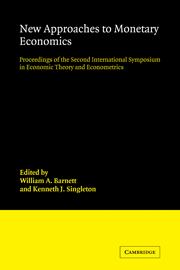 New Approaches to Monetary Economics
New Approaches to Monetary Economics Published online by Cambridge University Press: 04 August 2010
In this chapter we study an economy in which there are two technologies for making payments. The first is currency; the second, bank drafts drawn on interest-bearing demand deposits. The interest-bearing asset does not dominate the noninterest-bearing currency because there is a fixed recordkeeping cost incurred whenever a bank draft is used as the means of payment. The steady-state equilibrium is characterized. It is found that the value of the good or (more precisely) package of goods purchased at a given location determines which means of payment is used. Bank drafts are used for large purchases and currency for small purchases.
In the environment studied, the highly centralized Arrow–Debreu competitive equilibrium is impractical, because the number of date-, event-, and location-contingent commodities is so large that the resources required for information collection and processing would be prohibitive. In this sense we follow Brunner and Meltzer (1971) and consider as the chief role of money economizing on costly information collection and processing.
The approach is close in spirit to that of Townsend (1980), who views the payment system as a communication system. It differs in that no effort is made to find the best arrangement. The arrangement studied, however, is sufficiently explicit that one can calibrate the model and then examine the costs and benefits associated with modifying the scheme – say, by imposing reserve requirements or interest-rate ceilings. Upper bounds for the gains that can be realized from alternative systems can be computed.
To save this book to your Kindle, first ensure [email protected] is added to your Approved Personal Document E-mail List under your Personal Document Settings on the Manage Your Content and Devices page of your Amazon account. Then enter the ‘name’ part of your Kindle email address below. Find out more about saving to your Kindle.
Note you can select to save to either the @free.kindle.com or @kindle.com variations. ‘@free.kindle.com’ emails are free but can only be saved to your device when it is connected to wi-fi. ‘@kindle.com’ emails can be delivered even when you are not connected to wi-fi, but note that service fees apply.
Find out more about the Kindle Personal Document Service.
To save content items to your account, please confirm that you agree to abide by our usage policies. If this is the first time you use this feature, you will be asked to authorise Cambridge Core to connect with your account. Find out more about saving content to Dropbox.
To save content items to your account, please confirm that you agree to abide by our usage policies. If this is the first time you use this feature, you will be asked to authorise Cambridge Core to connect with your account. Find out more about saving content to Google Drive.